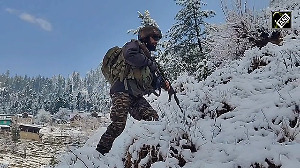
Despite a 'savage proxy war in Kashmir, periodic crises, meager diplomatic and economic relations, chronic everyday vituperativeness and -- most worrisome for some observer -- the two countries' increasingly intense competition in nuclear weaponization,' India and Pakistan have repeatedly backed off from a major war during the last few decades.
Why? That is what Dr Sumit Ganguly, Rabindranath Tagore Chair in Indian Cultures and Civilizations at Indiana University in Bloomington. and Dr. Devin T Hagerty, Associate Professor of Political Science at the University of Maryland, Baltimore County, try to find out in their recently released book, Fearful Symmetry, India-Pakistan Crises in the Shadow of Nuclear Weapons.
As the title suggests, the conclusion they arrive at is that the main reason for this restraint is the presence, and earlier, the suspected presence, of nuclear weapons by both sides. In the process, the authors also clinically review the Indian and Pakistani domestic political systems since Independence, particularly in the six instances when the two nations almost launched a full-fledged war, but finally didn't.
Excerpts:
In the early 1980s, Indian civilian and military planners seriously considered launching preventive air strikes against Pakistan's evolving, but disaggregated, nuclear capabilities.
In turn, worried Pakistani leaders warned the Indian government that they would respond to such an attack by ordering their own air strikes against New Delhi's nuclear facilities, thereby spreading lethal radioactive materials into densely populated Indian cities.
Islamabad's fears reached their apex in 1984, when two squadrons of Indian Jaguar fighter-bombers seemingly went missing. Pakistani officials feared that the undetectable Jaguars had been moved by the Indians in preparation for a preventive strike against the Kahuta uranium enrichment facility, and they repeatedly called on their then US ally for protection.
Ultimately, India and Pakistan restrained themselves from fighting.
In the 1984 crisis, none of our three propositions fared very well.
[The three propositions are:
-
Unipolarity theory: Timely and forceful US intervention
-
Nuclear deterrence theory: Fear that war might escalate to the nuclear level.
-
Conventional deterrence theory: The lack of sufficient conventional military superiority to pursue a successful blitzkrieg strategy.]
Instead, the main source of Indo-Pakistani peace seems to have been 'boosted conventional deterrence' -- the mutual fear of the adversary striking one's own nuclear facilities with advanced conventional weapons.
This conclusion is strengthened by the fact that, in the immediate aftermath of the crisis, India and Pakistan reached an agreement not to attack each other's nuclear sites, the fist of its kind in the nuclear era.
In 1986-7, New Delhi and Islamabad endured a long crisis emanating from India's 'Brasstacks' military exercises, the largest in South Asia's history. Brasstacks set off a process of competitive mobilization -- and nearly a war-between India and Pakistani military forces that faced off all along the border in a chain reaction of military moves and countermoves.
Why India cannot win a war against Pakistan
The two sides backed down from their war footings in early 1987. India and Pakistan's nascent nuclear weapon capabilities had little discernible impact on the outcome of the crisis, which was resolved peacefully mainly because India lacked the requisite conventional military capabilities to launch confidently a blitzkrieg-style invasion of Pakistan.
Islamabad, in 1987, was at the height of its conventional military sophistication, given the inflow of weapons and technology stemming from the US preoccupation with supporting the anti-Soviet guerrilla forces in Afghanistan.
Moreover, while India enjoyed overall conventional military advantages vis-à-vis Pakistan, many of its best army divisions were pinned down on the Himalayan frontier, where Indian forces had skirmished with China's in 1986.
The US role in the Brasstacks crisis was minimal, consisting mainly of providing information and reassurance to both sides in an attempt to counteract the mutual mistrust and appallingly bad intelligence that structured the crisis.
In 1990, India and Pakistan engaged in an intense, months-long crisis over the emerging Islamist insurgency in Indian Kashmir. As Islamabad dramatically stepped up its support for the Muslim militants across the LoC in Kashmir, New Delhi ordered a brutal crackdown on the insurgents.
National temperatures rose, and the Indian and Pakistani militaries were partially mobilized, moved towards sensitive border areas, and put on high alert.
Goaded by the public outcry over Kashmir and opportunistic opposition politicians across the political spectrum, both governments issued shrill nuclear-tinged rhetoric in the spring of 1990. US officials beam so alarmed by the situation in April and May that President George H W Bush tried to calm tempers by sending a senior foreign policy team to both countries.
Ultimately, the two sides baked away from the brink of war, owing to the twin restraints of nuclear deterrence and timely and forceful US intervention.
New Delhi and Islamabad had already determined by the time of the US crisis management initiative that the stakes of a war in 1990 were simply too high due to the existential deterrent effects of their mutual nuclear weapon capabilities.
Resolute US diplomacy both reinforced that realization and facilitated face-saving steps back from the brink of war.
In 1998, New Delhi sparked another crisis by conducting a series of nuclear explosive tests on 11 and 13 May. A few weeks later, after considerable external pressure and internal debate, Islamabad followed suit.
For much of the time between the Indian and Pakistani tests of 1998, Pakistani officials worried -- as they had in 1984 -- about the possibility of an Indian preventive strike. The tit-for-tat South Asian nuclear tests then created a spiral of alarm that raised mutual fears of pre-emptive nuclear strikes, put the two sides' military forces on high alert, and generated an atmosphere of extremely bellicose rhetoric.
Again, however, military hostilities were avoided. We argue that this result was again the outcome of existential nuclear deterrence: neither side could have had confidence in carrying out an effective, decapitating first strike against the other side's nuclear assets.
The conventional deterrence explanation fails with respect to 1998, because by that time India had regained and was widening its conventional military advantages over Pakistan.
Our US intervention proposition is weak in explaining Indo-Pakistani restraint in 1998; indeed, the US role appears to have been ineffective, largely due to the inflexibility of US laws in 1998.
The years 1998 and 1999 brought an empirical playing-out of the stability-instability paradox. Pakistan covertly infiltrated soldiers into the remote Kargil region of Indian Kashmir, in a surprise initiative that sparked a robust Indian military response -- but one carefully limited to the Indian side of the disputed territory.
Kargil was, in fact, a war, and thus represents the second exception to the theoretical law that nuclear weapon states do not engage in direct military conflict (the first being the Sino-Soviet border clashes of 1969).
Why did the Kargil war not spread and develop into a major Indo-Pakistani war?
First, New Delhi studiously avoided expanding its military operations beyond the Kargil area, due to its fear that escalation might ultimately create a situation in which nuclear weapons could be used.
This is a point that bears reiteration: despite severe provocation, India limited its war-fighting operations not only to the disputed territory of Kashmir, but to its own side of the LoC in Kashmir.
Absent nuclear weapons, Pakistan would probably not have undertaken the Kargil misadventure in the first place; but absent nuclear weapons, India would likely have punished Pakistan much more severely for violating the LoC in such a blatant and duplicitous fashion.
A secondary but very important war inhibiting factor in 1999 was the Clinton administration's strong pressure on Islamabad to cease and desist in Kargil.
In late 2001 and 2002, New Delhi responded to an audacious Pakistani-supported terrorist attack on the Indian Parliament by fully mobilizing its military forces along the international border and the LoC in Kashmir.
After Islamabad responded with its own massive troop build-up, an estimated one million Indian and Pakistani soldiers were poised on high alert along the entire Indo-Pakistani frontier. Both sides' armoured formations stood ready to launch offensive strikes deep into the opponent's territory, and short-range ballistic missiles were moved to border areas.
By the time it was defused in autumn 2002, this latest crisis had generated the largest South Asian military build-up since the 1971 Indo-Pakistani war. After nearly a year of crisis-grade tension, however, India and Pakistan once again eased themselves away from the brink of war.
Nuclear deterrence again seems to provide the best explanation for that outcome. With Pakistan now an established, unambiguous nuclear weapon state, Indian decision-makers were loath to undertake attacks -- either in Kashmir or across the international border -- that might provoke Pakistani escalation to the nuclear level.
Absent nuclear weapons, India by 1999 was clearly in a position of sufficient conventional superiority that it could have ordered a successful blitzkrieg attack against Pakistan.
The US role, as in previous crises, was that of a facilitator of peace, providing both sides with the political cover they needed to stand down while still saving face.
Extracted with permission from Fearful Symmetry: India-Pakistan Crises in the Shadow of Nuclear Weapons, by Sumit Ganguly and Devin T Hagerty, co-published by Oxford University Press India and University of Washington Press.
Illustration: Uttam Ghosh






 © 2025
© 2025